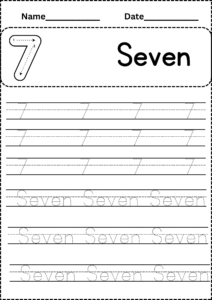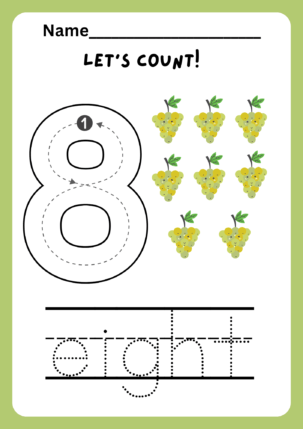Number Tracing Worksheets 1 – 10 Free: A Complete Guide for Parents and Teachers
Teaching young children to write numbers can be both exciting and challenging. To make this learning process engaging and effective, number tracing worksheets 1-10 are an invaluable resource. These worksheets are designed to help children in preschool and kindergarten develop their number recognition and fine motor skills. In this article, we will explore the benefits of using number tracing worksheets, provide a detailed overview of what they include, and answer some frequently asked questions.
What are Number Tracing Worksheets 1-10?
Number tracing worksheets 1-10 are educational tools that help children practice writing numbers from 1 to 10. Each worksheet in a bundle typically includes:
- Traceable Numbers: Large numbers with dotted lines that children can trace over to practice their writing.

- Practice Space: Additional lines or spaces where children can try writing the numbers on their own.

- Fun Themes: Engaging themes and illustrations to keep children interested and motivated.
These worksheets are perfect for both classroom settings and at-home learning.
Benefits of Number Tracing Worksheets 1-10
- Develops Fine Motor Skills: Tracing numbers helps children improve their hand-eye coordination and control over writing instruments. This is crucial for developing fine motor skills, which are essential for many daily tasks.
- Enhances Number Recognition: Repeatedly tracing and writing numbers helps children recognize and remember them. This is the foundation for more advanced math skills.
- Promotes Writing Skills: By practicing tracing, children learn the correct way to form each number. This practice is important for developing neat and legible handwriting.
- Boosts Confidence: As children practice and improve their number writing skills, they gain confidence in their abilities. This positive reinforcement encourages them to keep learning and practicing.
- Engaging and Fun: Themed worksheets with colorful designs and illustrations make learning enjoyable. When children have fun while learning, they are more likely to stay engaged and retain the information.
Frequently Asked Questions (FAQs)
Q1: At what age should children start using number tracing worksheets?
A1: Children can start using number tracing worksheets as early as age 3 or 4, depending on their development. It’s important to ensure they can comfortably hold a writing instrument and have some basic hand-eye coordination.
Q2: How often should children practice with number tracing worksheets?
A2: Consistency is key. Daily practice, even for just 10-15 minutes, can significantly improve a child’s writing skills and number recognition over time.
Q3: Can number tracing worksheets 1-10 be used for children with special needs?
A3: Yes, number tracing worksheets can be a helpful tool for children with special needs. They provide structured practice and can be adapted to meet individual learning requirements.
Q4: Are there digital versions of number tracing worksheets available?
A4: Yes, many educators and websites offer digital versions of number tracing worksheets that can be used on tablets or computers. These can be especially useful for on-the-go learning.
Q5: How can parents support their children while using number tracing worksheets?
A5: Parents can support their children by providing a comfortable and quiet workspace, offering positive reinforcement, and working alongside them to demonstrate proper number formation.
Conclusion
Number tracing worksheets 1-10 are an essential educational tool for young learners. They provide a structured and engaging way for children to practice writing numbers, develop fine motor skills, and enhance their number recognition. By incorporating these worksheets into their daily routine, parents and teachers can help children build a strong foundation for future math success. Whether used in the classroom or at home, number tracing worksheets 1-10 are a fun and effective resource for early childhood education.














Reviews
There are no reviews yet.